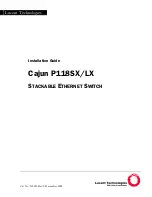
17
18
3.3 VT-100 SOFTWARE CONFIGURATION
This section describes the VT-100 configuration using a 1001CC.
For information on configuration using SNMP through the 1001MC,
please refer to the 1001MC user manual.
The NetLink-E1™rack card features a VT-100 menu-driven system
that may be used for local configuration and management. Cards are
configured and managed by setting a separate address for each card
using hardware switches and then accessing each card using a rack
mounted NetLink Model 1001CC control card. The software manage-
ment system is described below. For more information on the Model
1001CC, please refer to the Model 1001CC user manual.
3.3.1 Setting the Card Address
The 2701RC contains two rotary switches (S3 and S4) which are used
to set the address of the card. Figure 8, below, shows a close-up of
S3 and S4 and the addressable digits.
Switches S3 and S4: Card Address
Switches S3 and S4 are used to set the address of the card.
Switch S4 is the tens place digit and S3 is the ones place digit.
Following are examples of address settings
(Default Address= “00”)
S4
S3
RDL Type
0
4
Card Address = 04
5
2
Card Address = 52
8
6
Card Address = 86
3.3.2 Accessing the Menu System
1) Set the Card Address as described in Section 3.2.1.
2)
Set S2-7 to the OFF position to select VT-100 control.
3)
Power up the terminal and set its RS-232 port as follows:
9600 Baud
8 data bits, 1 stop bit, no parity
Local echo off
ANSI or VT-100 emulation
4) Here is an example of a terminal emulator setup session. In
normal font are the various parameter types. In bold type are
the values that should be used for best results. Your terminal
program’s setup screen may differ from this one:
5) Install the 2701RC and the 1001CC Control Card into the rack
system (see Section 4.0 Installation, page 32, to install the
2701RC; see the 1001CC User Manual to Install the Model
1001CC Card and to connect the RS-232 port).
6) After your 2701RC units are installed and you have set up
your Model 1001CC and VT-100 terminal as described above,
you are ready to access the 2701RC cards. This is done by
selecting the address for a card using the command “Ctrl-b”
address <CR>. For example, if your 2701RC has an address
of “64”, type the following:
Ctrl b
(Hold down the
Ctrl
key and depress the b character)
64
(Type in the address 64 )
<CR>
(Depress the Enter/Carriage Return key)
0
1
9
6
7
2
8
3
4
5
0
1
9
6
7
2
8
3
4
5
S3
S4
Figure 8. Close-Up of Switches S3 and S4
Baud rate: 9600
Parity: None
Data Length: 8
Stop Bits: 1
Default terminal type:
VT-100
Local Echo:
Off
Add Line Feeds after CRs:
Off
Received Backspace Destructive:
On
Backspace key sends:
BS
XON/XOFF software flow control:
On
CTS/RTS hardware flow control:
Off
DSR/DTR hardware flow control:
Off
NOTE: The Model 1001CC uses an internal bus to communicate
with the 2701RC. When using software configuration, the rear
card for the 2701RC should be configured with FRGND and
SGND connected. Please see section 3.2 for more information
on configuring your rear card.











































